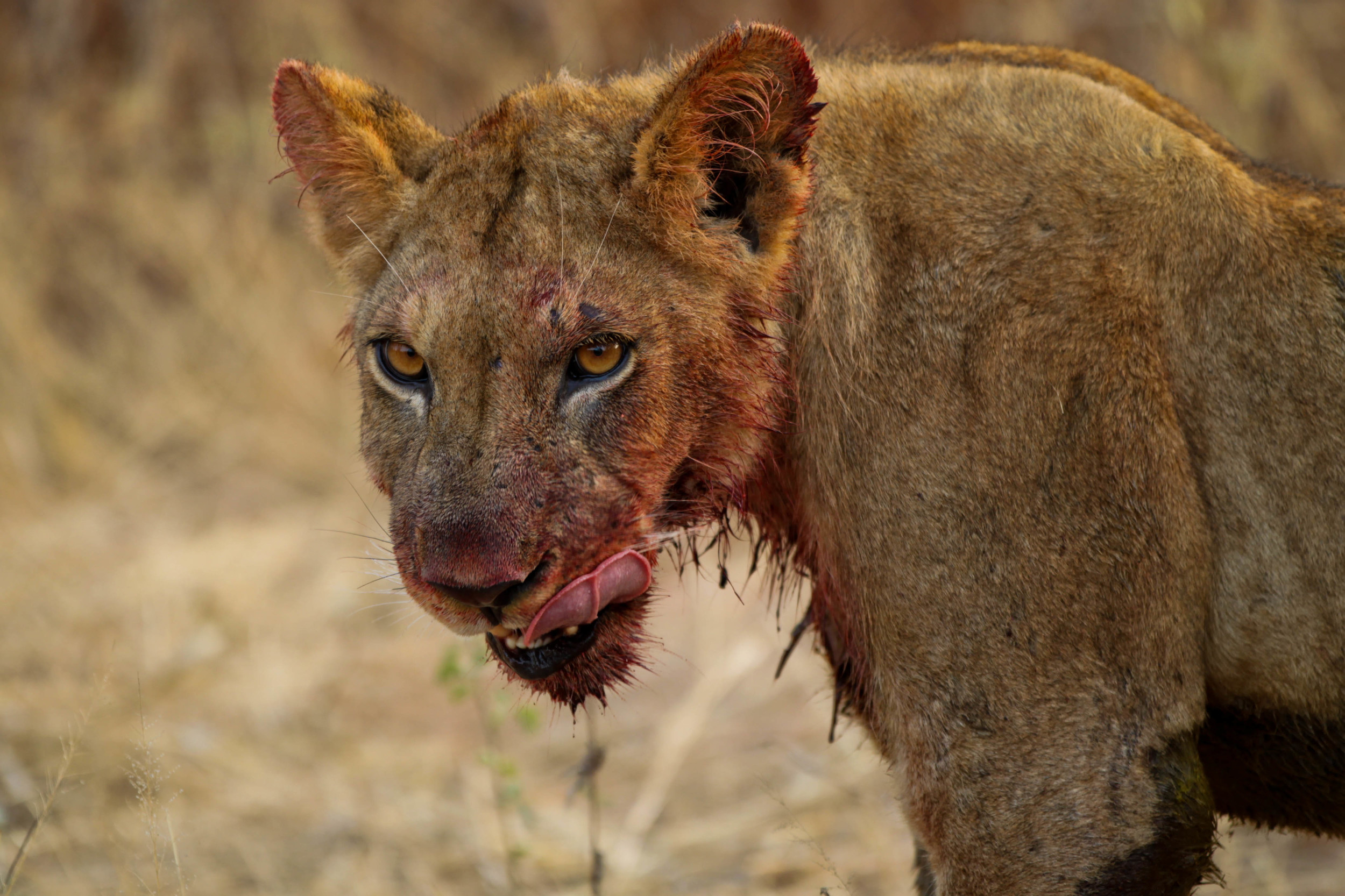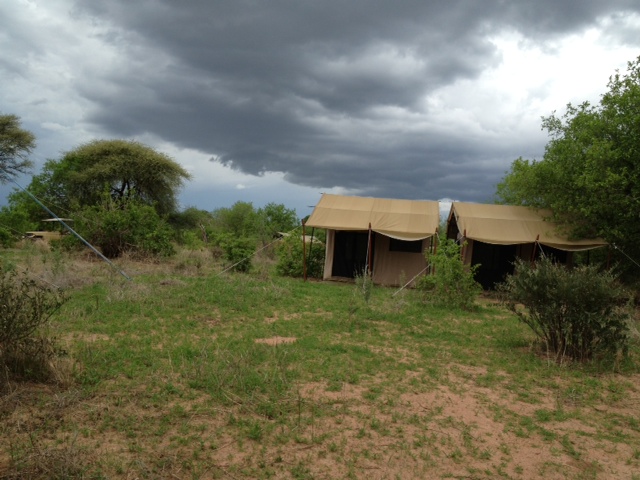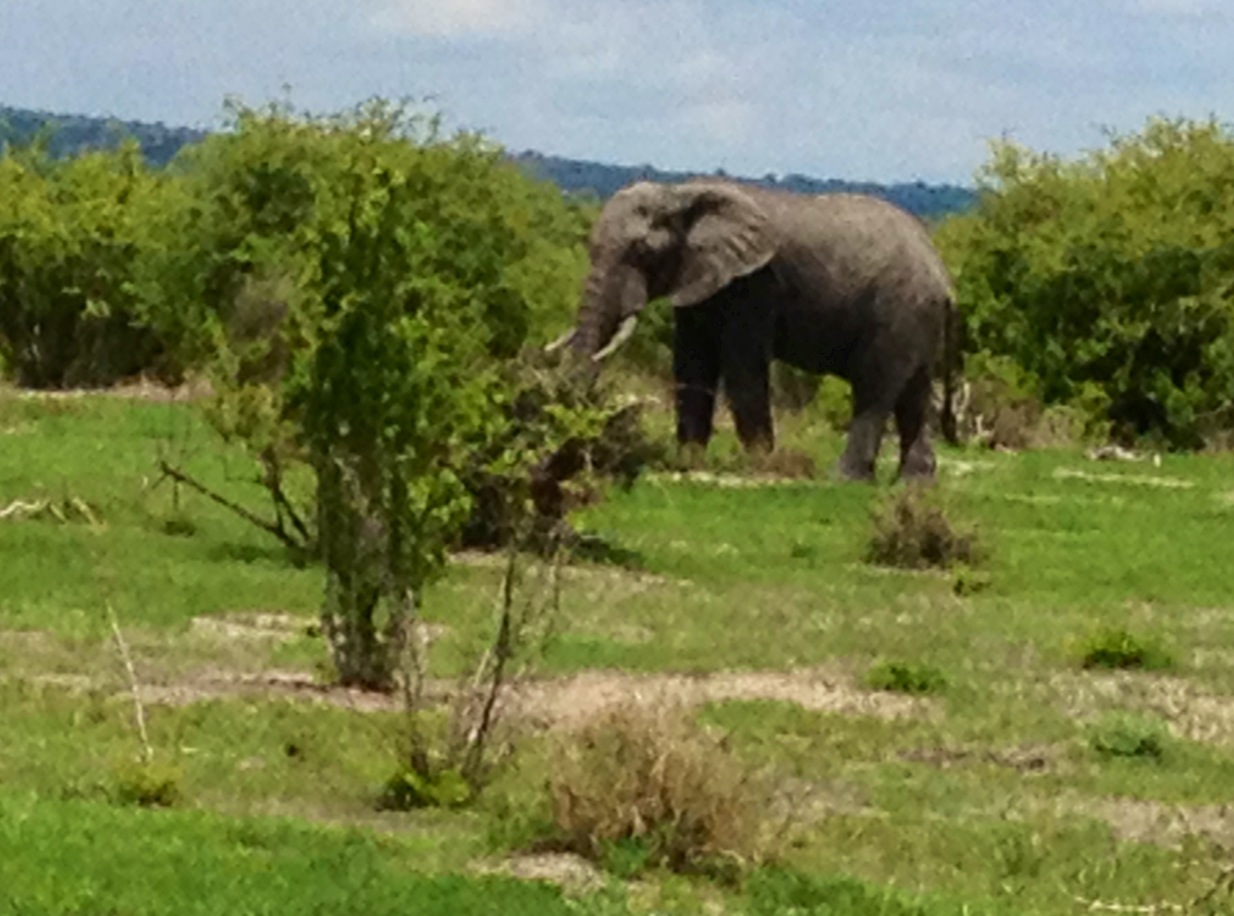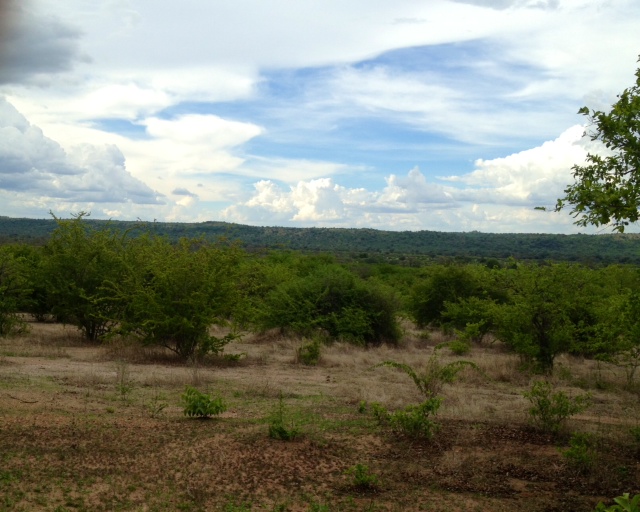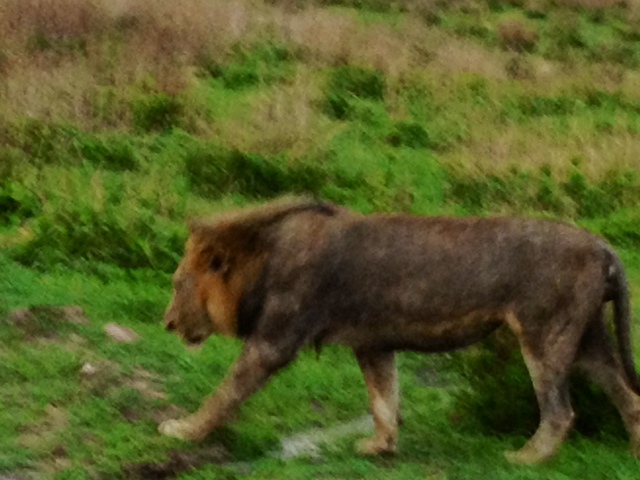Day One – Kwihala Camp
So we rush – well actually creep in
a hurry - out of Dar, battling 6 A.M. traffic, a function of there basically
being only two paved roads in all of Dar, to arrive at the domestic air
terminal on time for our 8:30 bush air flight (think Robert Redford and what’s
her name in Out of Africa) to Mesembe, a short dirt airstrip at the edge of the
Ruaha National Park, where we are met by our guides Lorenzo and Saidi
(pronounced “sah ee dee”), their twenty year old Toyota land cruiser, cold
drinks, a small herd of elephants, some lovely impala, and one lonely zebra. And rather than going straight to our tent
site, Lorenzo suggests we go on a game drive first. I mean isn’t that what we’ve come here
for?
The air smells spectacular, almost totally free of pollution and contaminants, the smells changing as frequently as the landscape, my entire sense of smell awakened. Here the scent of elephant. Here Jasmine. Here something like baking potatoes. Here onions or leaks. Here the smell of the earth itself, of dry riverbed, of fetid pools, of musk and rotting wood, of old bones and fresh kill. We chose Ruaha as our safari destination specifically because of its non-touristy remoteness, and within eight hours of game driving on our first day here we are rewarded by seeing no other people, no other vehicles, and no evidence of any human presence other than the narrow dirt roads we drive upon and the tire tracks we’ve made. On the way into safari camp for lunch we also see three immense giraffes happily picking at and pruning the tops of tall bushes. They are so majestic, graceful, and a not just a little weird looking, their heads the models for creatures I’ve seen in a Star War movie. And they think we are weird looking too, you can see it in their eyes as they peer down at us, seated on our rumps, knees up into our chests, unmoving. We also see a giraffe skeleton, bone white and dry, a threatening sky, three miniature gazelles that charge around like rabbits, and the carcass of a very young freshly killed dikdik being worked over by bugs and vultures.
When we arrive at Kwihala Camp around 1 p.m. we are met with cold drinks, wet hand towels to wipe down with, porters who graciously take our packs, and Sara, the Danish born camp manager who moved to Tanzania decades ago as a child, who joins us for lunch and advises we must always wait to be escorted to and from our tent at other than daylight hours. The tent is a brilliantly designed, quite substantial, eight foot tall canvas and mesh structure with sewn in vinyl flooring, a working flush toilet, a sink, and a once per day hot water shower, with cold showers at any time. Lunch includes mango chutney, grilled chicken, fresh rolls, and fresh salad. It is the best food I have eaten in a month.
In the afternoon, on our second game drive of the day, when it starts raining very hard, we just stop the land cruiser, throw on the rain ponchos provided, angle the open sided windshield-less vehicle so that the least amount of the wind driven rain is coming in, open the can of roasted cashews and a beer we’ve been provided, and sit watching a herd of at least thirty to forty impala, including delightfully frolicking new borns, grazing and enjoying their showers, listening to bird calls - a surprising range of which Lorenzo can identify - and casually studying a variety of beetles and other creatures scurrying out of their habitations in the ground, hurricane victims again, swept up in yet another flood of biblical proportion (if you live in a hole).
The highlight of our afternoon, after the rains have moved on and the deliriously diverse smells of a dewy planet are upon us is Saidi spying a male lion’s ears sticking up just above the brush about 200 meters from the road. How Saidi does this time and again, how he routinely sees the things he sees hidden from our eyes in the bush, becomes a source of ongoing wonderment and delight during our four day and night stay here. Once we stop our vehicle we position ourselves so that we can clearly see the lion moving through the bush, and once Saidi has assessed the lion’s likely path we drive to the point on the road where Saidi anticipates the lion will cross, as we turn off the engine, and wait, quietly listen to his bellowing roar, faintly hearing a responding roar at some great distance beyond where we are sitting, and watching two lion cubs play like young house cats do, chasing and rolling over one another, in the dry Megusi River bed.
In time the lion ambles past us, within ten feet of our vehicle actually, his walk so graceful and soft, his ears high, his eyes focused, and in no particular hurry or concern for the truck. Once at the road the lion opens his jaws, pulls back his lips in what appears to be a snarl, but is not, and activates something inside his mouth connected to his nasal passages, with which he “smells” the air, its scents, and our familiar, informative, and non-threatening odor. We try to follow him, Lorenzo says he is part of a dominant adult male hunting pair whom guides in the park have previously named Brother and Grumpy, but Brother crosses a small ravine and when we try to follow him the limitations of our vehicle are immediately apparent, our hunt for the day is over, and we drive back in the dark to our camp where a hot shower and dinner awaits us.
After dinner, as we walk back to our tent and I watch Saidi - ridiculously I think - swinging his flashlight back and forth across the path and into the bush I teasingly say, “Come on, Saidi, what in the world do we really need to be so concerned about in the short two hundred yards between the dining tent and our tent?” Whereupon Saidi points out - this is no exaggeration - a six foot long deadly black necked cobra slithering toward a tree, a nine inch long human index finger thick millipede crawling next to us, and a black, violet, and red scorpion the size of Texas that I almost step on as he replies, “Everything.” Once back in the tent I zip it up very tightly.
Day Two – The Kil
We are awakened at 5:30 A.M. with tea and coffee brought to our tent. We are then escorted up to the land cruiser in the dark at 6:00. The path is covered with the hoof prints of impala and paw prints of hyenas, who we actually heard during the night, although we had no idea what it was, rubbing against the tent.
Once on the road the day breaks beautifully, although game is scarcer after the rains because the range of edible grasses increases overnight and watering holes are more spread out and numerous. Our first stop is actually for a small patrol of matabilie (sp?) ants as they cross the road in a tight two by two and three by three file that is about three meters long, out on an exploratory expedition searching for termites. We’ve stopped in part so that Lorenzo can describe to us the hunting behaviors of the ants we are seeing, but also because he does not want to run any over. This attitude of caring and respect for the Ruaha habitat and its creatures informs everything Lorenzo does.
The particular ant species hunting party we are watching is out searching for termites. It’s what they do. There are numerous other matabilie scouting expeditions simultaneously out from the ants’ home nest. Once a scouting party finds suitably vulnerable termites they raid the termites’ nest, kill some of the guards, steal some of the larva, and then march back, always in an orderly fashion, carrying their booty to the main ant colony and then dropping it, whereupon, when the other search parties have returned to the home nest and see the bounty, they join together as an entire and huge army of attack ants, led by the successful expeditionary party, now a significantly longer line of ants marching two by two, back to the termite colony where the slaughter begins in earnest. At the termite site, under full assault, what had previously been an organized line of ants literally marching two or three by two or three, turns into a swarm of ants, a mosh pit of delirious, frenetic, drunken ants, all bringing up dead termite soldiers, guards, and larva to the surface of the earth until the dead are piled high enough that each triumphant warrior ant can grasp five or six dead termites and termite larvae in its jaws and then the march in orderly fashion back to the ants’ nest with the kill where the ants drop and store their load, high five one another, call in the road crossing guards with their stop signs and iridescent vests, and celebrate their bounty, the lack of ant lost ant lives, and to rest after a good days hunt or harvest. I don’t see this last phase of the hunt, but I witness every other phase over the course of the day and after the first expeditionary force that initially caused us to stop to permit their passage is completely across the road – the crossing guards with their signs and cute iridescent orange vests are last to cross – we too are on the way.
After a breakfast eaten standing over a tablecloth spread on the land cruiser’s hood covered with baskets of rolls, cereal, milk, butter, jam, coffee, teas, and juice we are headed toward a mountain top viewing area when Lorenzo gets a call from Moses, one of the other guides (I don’t make up names like this … ant crossing guards with iridescent vests maybe … but not Moses), who advises Lorenzo of his location and says he and his partner Samson have spotted something we might like to see. It takes us about half an hour, driving fast for the firs t time, but when we get to the site where Moses awaits us we are “rewarded” with the sight of a huge recently killed adult male giraffe being systematically and thoroughly devoured by the nine lioness hunting pack that has brought the giraffe down – first by one lioness grabbing and clenching the giraffe’s tail in the four hundred pound lioness’s powerful jaws and thus slowing it down before the giraffe was able to get up to escape speed, another lioness jumping on the giraffe’s back, others clutching and severing the tendons of its legs in their jaws until finally it falls, mortally wounded on the very day the Mayans predicted centuries ago that its life on Earth and all it knew would end.
One of the lionesses takes the jaws of the downed but still living giraffe into her own jaws and clamps the giraffe’s mouth and nostrils shut so it is deprived of oxygen, its suffering and all movement soon ended. The lionesses then first eat the soft ears and lips of the giraffe, like matador trophies awarded after an aesthetically pleasing kill. Next they work as a team ripping open the belly of the giraffe from anus to sternum, eating the soft internal organs first before moving on to other cuts of freshly killed meat. By the time we arrive the body cavity is completely opened, the stomach and the intestines emptied of their contents and completely consumed, and thousands of flies are buzzing inside the body cavity, professional mourners and wailers paid in blood for their keening cries. Four of the lionesses are working on the soft easily accessible and long neck, ripping back skin, tearing our tendons and flesh, blood literally dripping from their jaws and staining their cheeks. First they rip with their incisors, then they chew and sever with their canines. After they have had their fill they sleep and rest while other lionesses feast. When Grumpy and Brother appear the lioness back off and the kings are served. When Grumpy and Brother have had their fill the vultures step nervously in until the lionesses chase them off. The giraffe probably carried as much as one thousand pounds of flesh and internal organs. Over the course of a day or two spent at the kill the lions will each consume close to one hundred pounds of meat. We can see their distended bellies. We can hear their chomping jaws above the din of the flies. We can smell the giraffe’s open body cavity and slowly putrefying flesh. We are less than fifteen feet from this bacchanal, our cameras clicking, our hearts hurting and soaring all at once, our minds whirring, truly in awe, nature red in tooth and claw.
Finally dragging ourselves away from the kill we are headed back to camp for lunch when we observe a tree absolutely packed with preening vultures and are lured (by them?) to take a closer peek, whereupon once under their tree our vehicle sinks on all four wheels down to its axles and springs, each wheel spinning uselessly, as we are transformed from hungry happy campers headed home for lunch, into instant carrion, the Made in Tanzania packaging label reading, “Add ample sun, do not water, stir, and wait. Baking time a matter of taste.” The vultures, of course, see this all and are absolutely soaring, whirling and calling out to each other, high fiving like successful expeditionary ants in delight.
But fear not, kind reader. “A gooda guida is ajudged nota by whether he gets astucka,” declares Lorenzo in his finest English, “but by awhether he gets aunstucka.” Here’s how it is done.
Take the spare tire out from the rear of the land cruiser and lay it on the ground so you can rest the base of your jack on the hub of the tire, thus stopping the jack from sinking into the muck. Apply your full body weight to the jack handle a few dozen times, thus raising the wheel a centimeter at a time and getting the springs above the muck. Take out safari issue shovel and dig around and under the raised wheel. Gather reasonably sized twigs, branches, and dried grasses and created a substantial wooden platform under the tire. Lower the tire. Repeat four times. Get native Ngindo guide and ancient American to push on the front of the cruiser, rev to max, drop into gear. And presto, in a mere forty or fifty minutes you have left dozens of vultures mourning their empty stomachs, powdered carrion mix scattered unusably about the bush as if evaporated, as we head home for grilled fish skewers, carrots, and a nap. What’s good for a lioness is good for me, I say.
Now for our afternoon adventure what can we find? Giraffes who think they are hiding by going around a tall bushes and then peaking out over the top pretty much in full view from the neck up? Nervous elephants with nursing babies under a year old who charge your vehicle flapping their big winged ears and snorting until Lorenzo stands up, points authoritatively at them and shouts in Swahili, “Hey you!” which stops them every time, at least so far. Seeing the completely camouflaged monitor lizard, which no human being other than a Tanzanian raised in the bush can spot.
Awakened by a 1:30 A.M. phone call from Joy in which I find myself incapable of sensible speech - probably because I cannot sort out and prioritize what I might share of the marvels of Ruaha, or the experience of travel and of finding this stranger living inside my body, or the deep love, longing, and necessary separateness I feel from Joy, and my residual frustration that I have downloaded so many videos I can’t cram anything further onto my hard drive, which has kept me up deleting files past midnight, and not wanting to share my raw emotions openly in front of my sleeping sister, nor wanting to step out into the buggy night, I say to Joy that I am at a loss for words, whereupon Sheryl stirs and says, “That’s the first time I’ve ever heard that from you.” Yet it is true, I am speechless with wonder. Overwhelmed with amazement and gratitude.
To be continued … but in case I don't get to it ... remembering ...
Shockingly red mites the size and texture of Q-tip
ends.
Red headed, blue backed rock lizards having foot races across
the roof of the tent.
Male dung beetles
rolling their portable incubators along the ground until they meet a suitable
mate, plant a fertilized egg, only one per mating dung beetle couple, in the
dung and resuming their bachelor ways, tiny beetles having scavenged enough dung to kept the plains
from being completely shit covered.
The
roar of the lions and the responding call of lions.
Vultures who specialize in eating the dung of lions.
Baboon troops and
the baboon’s so human rear footprint.
Vervet monkeys, crocodiles, hippos, and dancing gray crowned stork.
All that remains of the
giraffe.
Small terrapins.
A van filled as full as a small circus car, which disgorges an
entire small Indian village out for holiday in the park.
The packs of mongoose.
The dry white shit of bone eating hyenas, usable as
chalk.
The heart opening attachment I
feel for this place and these people.
See -
